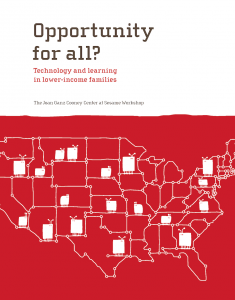
Recent research on digital media use points to two important gaps in educational opportunity for low-income families with young children. First, there is an access gap. Second, there is what scholars refer to as a participation gap, in which digital resources are not well guided or supported to ensure educational progress. Despite these barriers, many low-income families are using media and new technologies in creative ways to support their children’s pathways to success and to strengthen family relationships. In this report, media and policy expert Victoria Rideout and Rutgers University scholar Vikki Katz explore the current uses of digital technologies to help promote educational opportunities for all through a national survey of nearly 1,200 low-income parents of school-age children and in-person interviews with lower-income, Hispanic families in three communities located in Arizona, California, and Colorado.
Download the full report (PDF)
For more information, please see digitalequityforlearning.org.
On February 3, 2016, the Joan Ganz Cooney Center and Rutgers University presented Digital Equity: Technology and Learning in the Lives of Lower-Income Families at a forum co-hosted by New America in Washington, D.C.
View the presentations by Michael Levine, Victoria Rideout, and Vikki Katz below:
View the day’s full agenda here and the social media highlights here.
June 24, 2021:

Getting children back to school in September provides an unprecedented opportunity to do better by lower-income families—those who have borne the brunt of the impact of school building closures for more than a year and have been hardest hit by the health and economic crises of the pandemic. Published by New America, Learning at Home While Under-Connected: Lower-Income Families During the COVID-19 Pandemic follows up on 2016’s Opportunity for All? Technology and Learning in Lower-Income Families, to uncover the perspectives of lower-income parents with children ages 3 to 13. The report delves into their experiences learning at home, what they discovered about their children’s learning needs, and their priorities for the future. It provides timely, pointed, and thought-provoking insights on the challenges of being under-connected when trying to support young students at home without adequate devices and internet connections. Based on a telephone survey of more than 1,000 parents, the report also includes quotes and links to briefs from discussions with nearly three dozen lower-income parents in Pittsburgh, Detroit, and in Santa Clara County, CA.


